
A locomotive is a rail transport vehicle that provides the motive power for a train. If a locomotive is capable of carrying a payload, it is usually rather referred to as a multiple unit, motor coach, railcar or power car; the use of these self-propelled vehicles is increasingly common for passenger trains, but rare for freight trains.
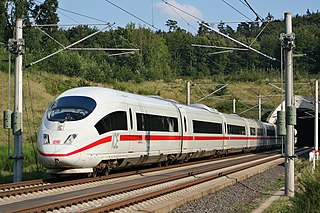
A multiple-unit train is a self-propelled train composed of one or more carriages joined, which if coupled to another multiple unit can be controlled by a single driver, with multiple-unit train control.

The TGV Duplex is a French high-speed train of the TGV family, manufactured by Alstom, and operated by the French national railway company SNCF. They were the first TGV trainsets to use bi-level passenger carriages with a seating capacity of 508 passengers, increasing capacity on busy high-speed lines. While the TGV Duplex started as a small component of the TGV fleet, it has become one of the system's workhorses.

Metrorail is an operator of commuter rail services in the major urban areas of South Africa. It is a division of the Passenger Rail Agency of South Africa (PRASA), a state-owned enterprise which is responsible for most passenger rail services in South Africa. The Metrorail system consists of 471 stations, 2,228 kilometres (1,384 mi) of track, and carries an average of 1.7 million passengers per weekday.

ER2 electric trainset is a DC electric multiple unit which was in production by the Railroad Machinery Plants of Riga from June 1962 to mid-1984. It was essentially an improvement of the ER1 design, featuring footboards for low platforms, and aprons for high platforms, as well as improved electrical equipment and minor changes to the bodywork. Since the mid-1960s, the ER2 has been the most widely used type of suburban train in the Soviet Union and its successor states.

NSB Class 66 was a three-car electric train used by the Norwegian State Railways for express trains on the Østfold Line to Halden and Gothenburg, and the Sørlandet Line to Kristiansand and Stavanger. The four multiple units were built by Skabo Jernbanevognfabrikk, with motors from Norsk Elektrisk & Brown Boveri, and delivered in 1945–46. They were originally named Class 106, but this was changed in 1956. The trains received the numbering BFM 66.01–04, B 66.31–34 and BS 66.61–64.

NSB Class 88 was a class of six three-car diesel-hydraulic multiple units built by Strømmens Værksted for the Norwegian State Railways. Derived from the German DRG Class SVT 877, the trains were the diesel counterpart of Class 66. The trains were built as express trains on the Bergen Line and the Dovre Line, serving the routes from Oslo to Bergen and Trondheim. The first four units were delivered in 1945 and 1946, but mechanical failures caused them to highly unreliable until 1950. Two more units were delivered in 1958. Retirement started in 1963 and from 1965 the trains were moved to the Røros Line. They left regular service from 1970 and were chopped three years later.
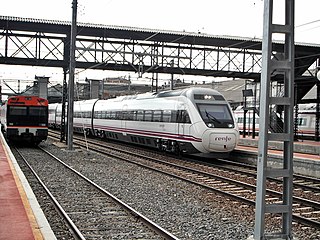
The Renfe Class 120 are electric multiple units used on Alvia high-speed rail services in Spain.

MetroBlitz was an experimental high speed commuter train service between Pretoria station and Johannesburg Park Station via Germiston, operated by the South African Transport Services (SATS). It started service on 16 January 1984.
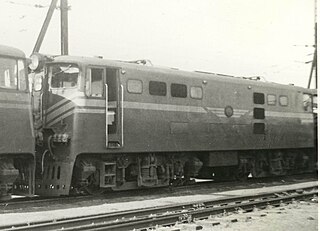
The South African Railways Class 5E1, Series 1 of 1959 was an electric locomotive.

The South African Railways Class 5E1, Series 2 of 1963 was an electric locomotive.

The South African Railways Class 5E1, Series 3 of 1964 was an electric locomotive.
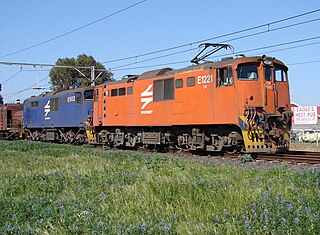
The South African Railways Class 6E of 1970 was an electric locomotive.
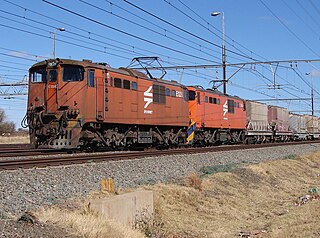
The South African Railways Class 6E1, Series 1 of 1969 was an electric locomotive.
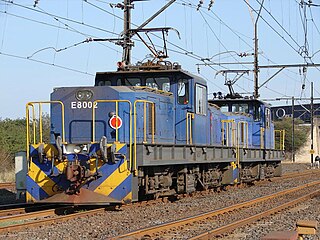
The South African Railways Class 8E of 1983 is an electric locomotive.

The South African Railways Class 12E of 1983 was an electric locomotive.
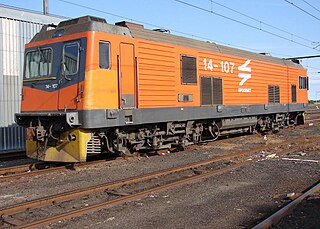
The Spoornet Class 14E1 of 1994 was a South African electric locomotive.

The class 3SUB were DC suburban electric multiple units, introduced by the London and South Western Railway in 1915. They were constructed by the Southern Railway in the period up to 1939, and though the class designation 3SUB was not used by the Southern Railway, some authors refer to these units as 3SUB. When rebuilt to four cars in the 1940s, they became class 4SUB.

The SNCF Class Z 5600 is a double-deck electric multiple unit trainset that is operated by SNCF on line C of the Réseau Express Régional (RER), a hybrid suburban commuter and rapid transit system serving Paris and its Île-de-France suburbs and the TER Bourgogne-Franche-Comté regional rail system.

The PNR EM10000 class is an electric multiple unit commuter trainset that will be operated by the Philippine National Railways on the North–South Commuter Railway. Prior to the reveal of its numbering scheme in October 2021, the train was known as the PNR Sustina Commuter. Set to enter service by 2028, it will be PNR's first trainset to be run on standard gauge and powered by electric traction. The trains are also designed to be interoperable with the Metro Manila Subway.





















